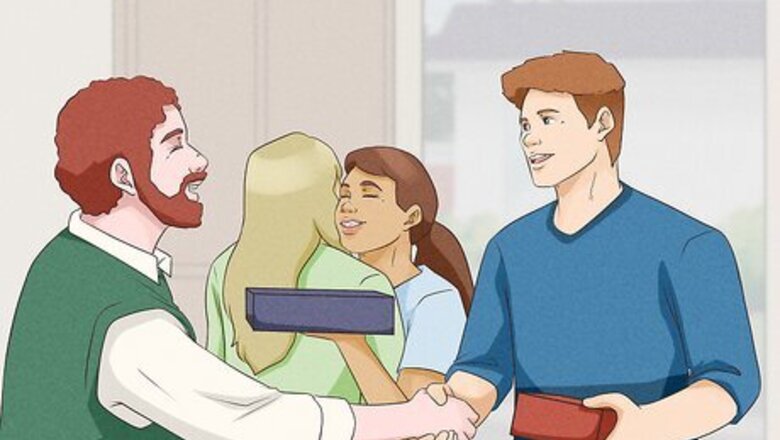
views
Arrival & Sitting Down
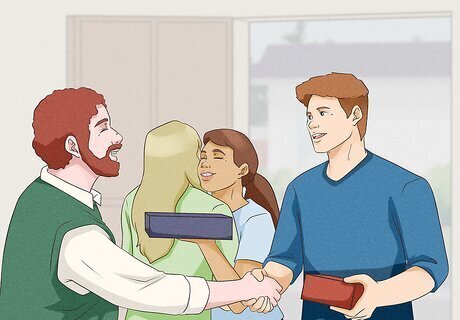
Arrive on time, and greet your host and the other guests. Whether you’re going to someone’s home or meeting for a reservation at a restaurant, it’s important to be punctual. Aim to show up on time, and if you’re going to be a few minutes late, call the host to let them know. When you do arrive, say “hello” to everyone present, and introduce yourself to guests you haven’t met before. If you’re going to be a guest at someone’s house, Claytor recommends bringing a gift for the host. “You can send it ahead of time, or you can bring it with you, depending on what it is,” she says. Good gifts for dinner party hosts include a bottle of wine, some fresh flowers, a cool coffee table book, a scented candle, or a high-end kitchen ingredient, like a bottle of fancy olive oil.
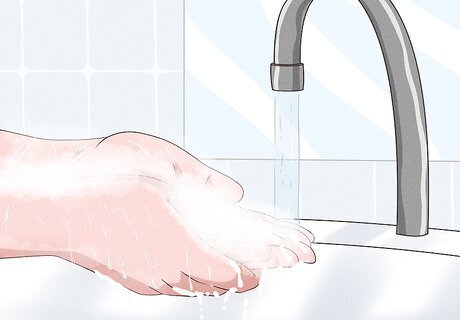
Wash your hands before you sit down. Make sure your hands are clean before you settle in for your meal. If you washed your hands right before you arrived, you’ll likely be able to skip this step, but if it’s been a while, head to the restroom and give your hands a good scrub. Some fancier restaurants will even bring you a dish of water to dip your hands in before your meal. However, this is usually reserved for fine dining.
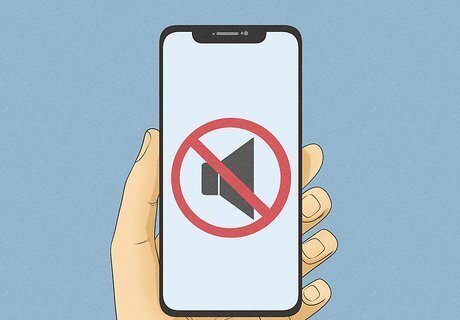
Silence your phone and put it away. At a nice dinner, no one wants to be interrupted by a ringing phone. Before you head to the table, put your phone on silent or vibrate, and stash it away in a pocket or a purse. If you get an important phone call, excuse yourself from the table to take it, so you don’t disturb any other guests. Try to keep your phone off the table while you eat. It can be a distraction to keep it so close to the food.
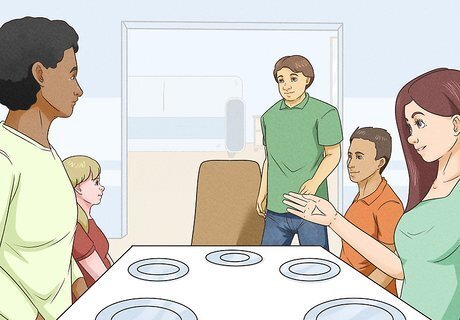
Wait for everyone to be seated before touching your table setting. If you’re at a dinner party, let everyone (including the host) take their seats before touching your place setting and moving things around. The same goes for a restaurant—once your party is seated, you can start getting settled. If there isn’t assigned seating, give the guest of honor or the host the best seat at the table (usually the head of the table). Everyone else can sit wherever they’d like. Always enter and leave the dining chair from the right side in a restaurant or at a formal dinner. If there’s a lady sitting on either side of you and you’d like to be chivalrous, you can also help her get seated. Pull her chair back, then push it in as she starts sitting.
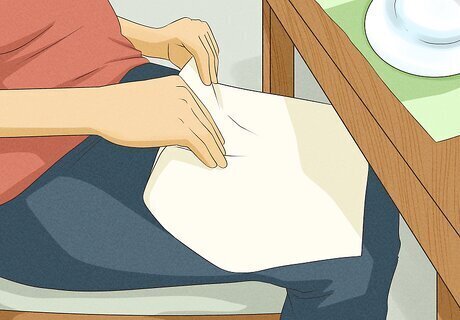
Place your napkin on your lap. “If there's a host or a hostess, wait to put the napkin on your lap until after the host or hostess does. If there's no host or hostess, when you sit down, you can just put the napkin on your lap,” Claytor explains. To do this, simply fold the napkin in half, then place it on your lap with the folded end closest to your waist. If you need to step out during the meal to use the restroom (or for any other reason), don’t put your napkin on the table. “Put it on your chair, because no one wants to see a soiled napkin where they’re eating,” Claytor says. This also signals that you aren’t done eating, and that you’ll be returning to the table soon.
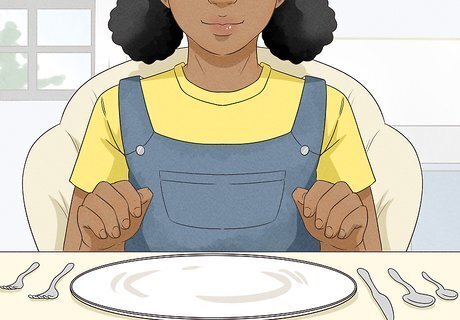
Keep your elbows off the table, and don’t slouch. When you settle in to eat, maintain good posture with your back straight, and tuck your elbows in by your sides. Putting your elbows on the table takes up a lot of space, and it’s considered bad manners. If you have any older relatives at the table, they might even call you out on it!
Etiquette While Eating
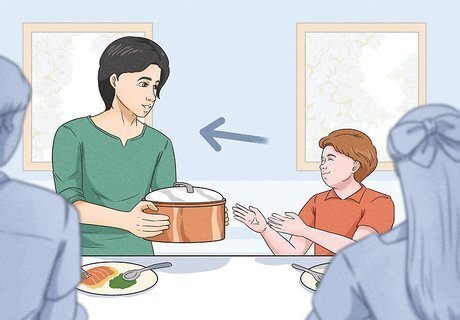
Pass all food dishes to the right. If you’re serving your own food from family-style dishes, scoop a serving of the food onto your plate, then hand the dish to the person on your right. Don’t reach across anyone to get food—politely ask them to pass you a dish if you’d like to serve yourself some. If you’re the first person to grab a roll from a bread basket or to cut into a loaf, serve yourself a piece, then offer one to the person on your left before passing it on to the person on your right.
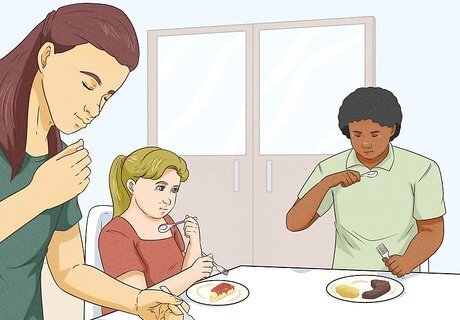
Don’t start eating until the host does. Even if everyone has their food in front of them, don’t dig in right away. It’s polite to wait for your host to start eating before you do (or to wait for the guest of honor, if there’s no host). Once they take their first bite, you can go ahead and start! Some people also like to say grace or make a toast before a meal. If this happens, wait to start eating until the prayer or toast has concluded. If you want to be the one to show appreciation for your host, consider offering up the toast yourself. Raise your glass, and thank them for opening up their home, says Claytor.
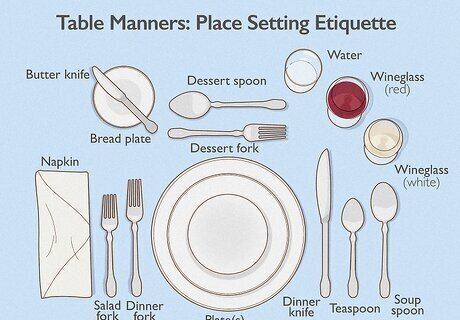
Familiarize yourself with the items on your place setting. Depending on how formal the meal is, there may be several pieces of dinnerware, flatware, and drinkware in front of you. If you know you’ll be attending a pretty formal dinner party, it’s a good idea to study up on each of these items, so you know when and how to use them. Here’s a breakdown of what you might find on your place setting at a formal meal: Butter knife and bread plate: The plate will likely be placed on the upper right-hand corner of your place setting, with the butter knife placed diagonally across it. Use the bread plate and butter knife to eat your bread and butter before the meal. Salad fork and dinner fork: The salad fork and dinner fork should be on the left side of your plate. The salad fork is smaller and placed on the outside, while the dinner fork is larger and placed nearest to the plate. Plates: Your dinner plate (and potentially a smaller plate or two for appetizer courses) will be in the center of your place setting. Dinner knife: Your dinner knife should be placed on the right side, directly next to your plates. Tea spoon and soup spoon: The teaspoon (which is smaller) should be right next to the dinner knife, then the soup spoon (which is larger) will be placed next to the soup spoon. Use the soup spoon to eat soup that’s served as an appetizer, and use the teaspoon to stir any tea or coffee you have after dinner. Dessert spoon and dessert fork: These utensils should be placed directly above your plate. Use them to eat your dessert course. Water and wineglasses: Your water glass and wine glass (if you’re drinking wine) will be placed on the top right side of your place setting.
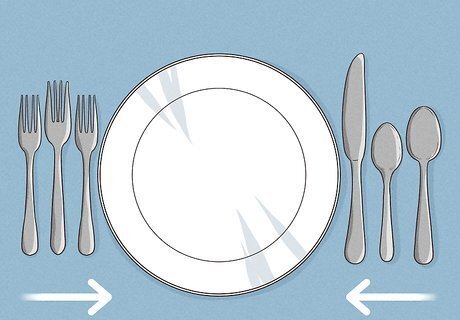
Use the utensils from the outside in. Fine dining place settings may have more than one set of utensils. If you aren’t sure which one to use, a good rule of thumb is to work from the outside in as you have each course. The utensils from the outside in on your left side will likely be a salad fork, a dinner fork, then a dessert fork. On your right, you'll likely have a soup spoon on the outside, then a tea spoon, then a dinner knife. If you’re at a slightly more casual dinner party with friends or family, you probably won’t have to worry about multiple sets of utensils. EXPERT TIP Tami Claytor Tami Claytor Etiquette Coach Tami Claytor is an Etiquette Coach, Image Consultant, and the Owner of Always Appropriate Image and Etiquette Consulting in New York, New York. With over 20 years of experience, Tami specializes in teaching etiquette classes to individuals, students, companies, and community organizations. Tami has spent decades studying cultures through her extensive travels across five continents and has created cultural diversity workshops to promote social justice and cross-cultural awareness. She holds a BA in Economics with a concentration in International Relations from Clark University. Tami studied at the Ophelia DeVore School of Charm and the Fashion Institute of Technology, where she earned her Image Consultant Certification. Tami Claytor Tami Claytor Etiquette Coach If you're a host setting the table for a dinner party, follow the BMW method. "B" stands for bread plate, and it's at the top left of the place setting. "M" stands for meal plate, which is in the center. "W" stands for water, which is on the top right. Place forks on the left, and knives and spoons on the right.
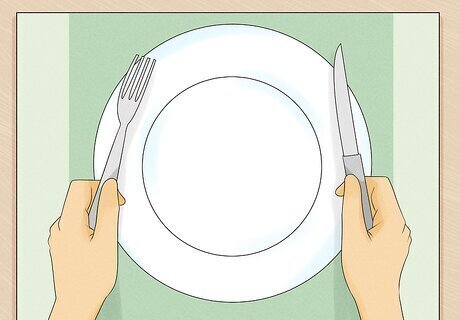
Hold your utensils correctly. “I'm going to discuss the U.S. way,” explains Claytor. “So, you pick up your fork in your left hand and your knife in your right hand, and you cut about four to five small bites—you never cut the whole thing at one time.” After cutting a few bites, “You put the knife on the edge of your plate and switch your fork from the left to the right hand, then you eat each small piece, one at a time slowly,” she says. This method is called the American Style, but there’s also a European/Continental style. In the European Style, you don’t switch your fork to the right hand after cutting. Instead, you eat with the fork in your left hand. Claytor warns against hunching over your plate to take bites of food. “You pick the food up when you're sitting at a 90 degree angle, and bring it up to your mouth—you don't bend over,” she says. Claytor suggests holding your fork at a bit of an angle, as well. “Sometimes, people dab at their food with the fork vertical. It should be a little diagonal, if not more parallel to the table,” she explains.
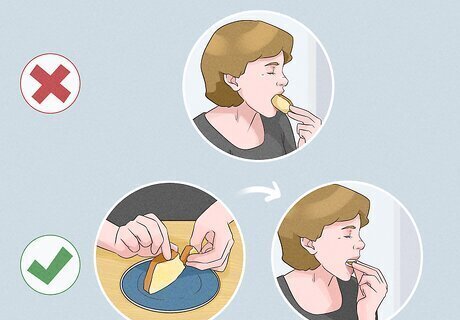
Eat slowly, and take smaller bites. At a dinner party or formal restaurant meal, you don’t want to be scarfing down your food very quickly. Instead, take your time, and try to pace yourself so you’re eating at about the same speed as the other guests. Cut a few small bites of food at a time, then eat each of them before cutting more. If you’re eating a roll or a slice of bread, tear off a small piece and butter it individually, rather than buttering the whole roll or slice at once. Don’t blow on your food if it’s too hot. Instead, wait a few minutes until it’s cooled down enough to eat it comfortably.
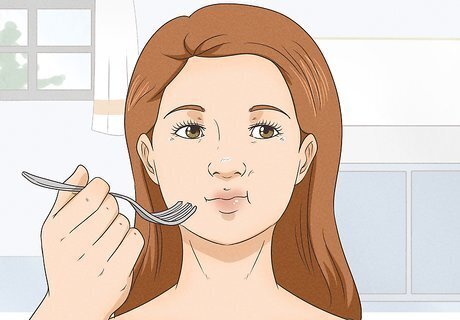
Chew with your mouth closed. Try not to show anyone your food as you chew, and don’t talk with your mouth full. If you want to say something, finish chewing your bite of food completely and swallow it before speaking up.
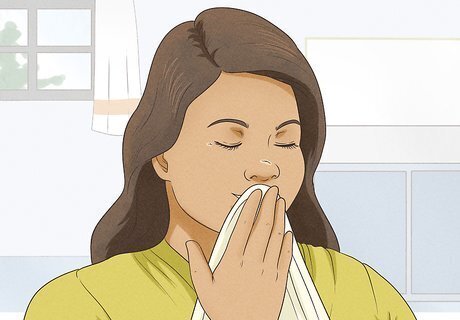
If you need to use your napkin, dab, don’t rub. “You want to use the napkin to tap your mouth—you don't want to rub it. It's just a very subtle tap,” explains Claytor. For example, if you take a bit of soup or a dish with a lot of sauce on it and you get some around your mouth, simply pick up your napkin and gently dab around your lips, then place the napkin back in your lap. Use your napkin to cover any burps, as well. If you feel a burp coming on, quickly cover your mouth with your napkin and keep your mouth closed so it isn’t loud. When you’re done, just say “excuse me” and keep eating. Don’t use your napkin to blow your nose at the table—this is unsanitary and unpleasant at a formal dinner. If you need to blow your nose, excuse yourself politely and head to the bathroom.
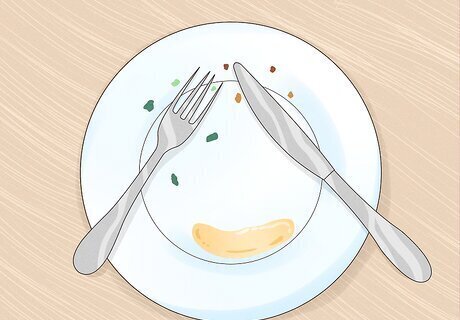
Place your utensils on your plate when taking a break. If you’re taking a short break from eating or waiting for the next course, cross your utensils on your plate. Place the fork on the left side with the tines (spikes) facing downwards, and place the knife on the right side with the blade facing towards you. Angle them so they’re forming an inverted V shape. This is the Continental style, which is considered best for more formal settings. If you’re using the American Style, rest both the fork and the knife on the right side of your plate, with the handles next to each other. Lay the fork with the tines facing up, and face the knife blade toward you. Either of these two methods will signal that you’re just taking a quick break, and that you’re not finished eating yet, so your plate won’t be cleared.
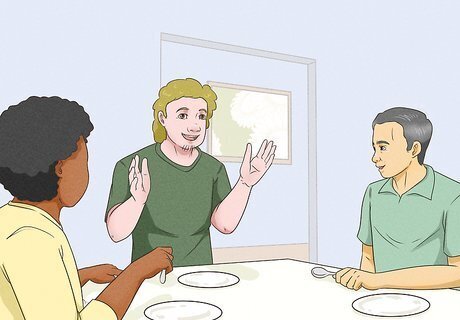
Make conversation with the people seated next to you. “As a guest, what you can do is always try to engage in conversation with the people to your left and to your right. Make sure the conversation is general, so that everyone can participate in the discussion, because if it's very niche, then people will be excluded,” explains Claytor. Remember, a dinner party or formal meal at a restaurant is about more than just food. It’s about connecting with the other guests and having a great time, and good, inclusive conversation is key for this. If you don’t know the people sitting next to you, introduce yourself and ask them how they know the host. That should be enough to get a lively conversation going. If you’re worried about coming up with things to talk about, check out this helpful list of conversation starters. Pick a few of your favorites, so you have them in your back pocket at the meal!
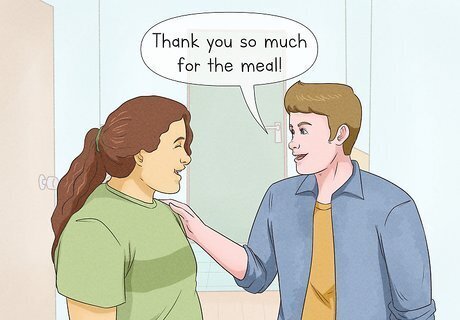
Say “please” and “thank you.” Make sure you’re polite and respectful to everyone around you when you ask them to pass you food or hand you more bread. If you’re being served your food at a restaurant, say thank you to the servers as they bring you items.
Ending the Meal
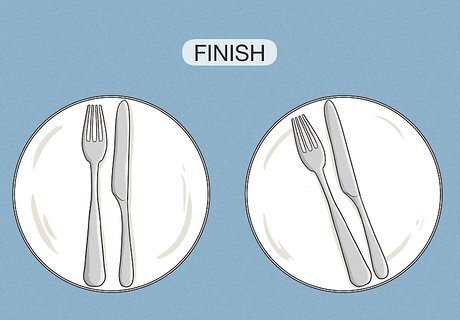
Place your utensils across the plate diagonally when you’re done eating. Once you’ve finished, place your fork and knife next to each other on your plate. If you picture your plate as a clock, the tines (spikes) of your fork and the tip of your knife should be pointing toward 10:00, and the handles should be pointing toward 5:00, so that they’re in a diagonal position. This signals to your host that you’re done eating if you’re at a dinner party, and it signals to your waiter that you’re ready to have your plate cleared if you’re at a restaurant.
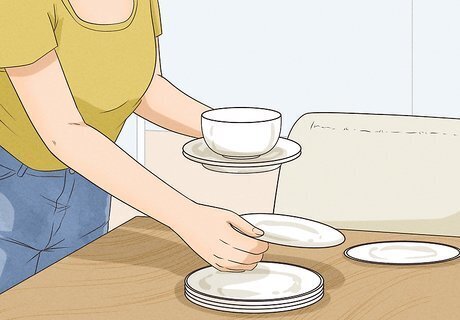
Help clear the table at the end of the meal. If you’re at a dinner party at someone’s home, pitch in with the clean-up. Help gather plates, napkins, and cups to bring to the kitchen. If you’re really feeling polite, you could even offer to wash the dishes! The host will really appreciate it, and you might just land an invite to the next dinner party.
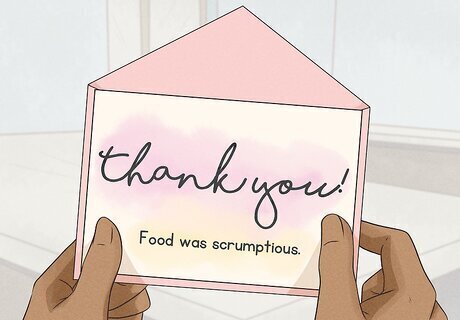
Write your host a thank-you note. “Once it’s over, always send a thank-you note,” says Claytor. This shows that you truly appreciated being included in the dinner party, and that you recognize the hard work they put into hosting. Write your message on some nice stationary, then send it to the host within a few days of the party.













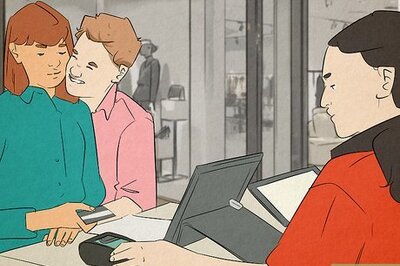

Comments
0 comment